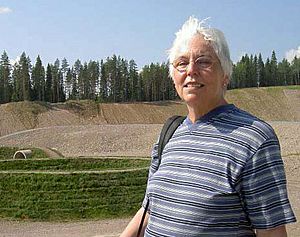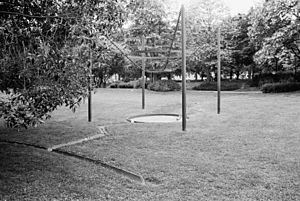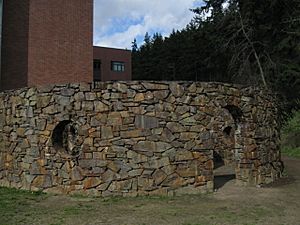Nancy Holt facts for kids
Nancy Holt (born April 5, 1938 – died February 8, 2014) was an American artist. She was best known for her amazing public sculptures, installation art, and especially her land art. Throughout her career, Nancy Holt also created films and photographs. She also wrote books and articles about art.
Contents
Biography
Nancy Holt was born in Worcester, Massachusetts, in 1938. She was an only child. She spent a lot of her childhood in New Jersey. Her father was a chemical engineer and her mother stayed home to care for the family.
Nancy studied biology at Tufts University in Medford, Massachusetts. She graduated in 1960. Three years later, in 1963, she married Robert Smithson. He was also a famous environmental artist.
Holt started her art career as a photographer and video artist. In 1974, she worked with artist Richard Serra on a video called Boomerang. In this video, she listened to her own voice echoing back to her. She described how strange this experience felt.
Her work with cameras and photography helped her create her later earthworks. These large outdoor artworks were like "seeing devices." They were fixed points that helped people track the sun, earth, and stars.
Today, Nancy Holt is most famous for her huge outdoor art pieces. These include Sun Tunnels and Dark Star Park. She created many other special artworks for specific places and times all over the world.
Holt wrote articles and took photographs for many publications. She also wrote several books. She won many awards, including five National Endowment for the Arts Fellowships. She also received the Lifetime Achievement in Contemporary Sculpture Award in 2013. From 1995 to 2013, she lived and worked in Galisteo, New Mexico.
In 2008, Holt helped stop a plan to drill for oil near her husband's famous artwork, Spiral Jetty. This artwork is located at the Great Salt Lake in Utah. After Robert Smithson died, Nancy Holt never remarried. She passed away in New York City on February 8, 2014, when she was 75 years old.
Artistic Style
What is Land Art?
Nancy Holt is known for her earthworks or land art. Land art started in the 1960s. This was when people in the United States began to care more about the environment. They wanted to understand how humans affect nature.
Land art changed how people thought about art. It moved art out of galleries and museums. Instead, it was created right in the natural landscape. These artworks were often huge and used parts of the environment itself. Unlike much art at the time, land art could not be bought or sold. This changed how people around the world saw art.
Land art was often made in remote, quiet areas of the country. The American Southwest was a popular spot. Some people think artists went there to escape the problems in the U.S. during the 1960s and 70s. Holt believed this art movement grew in the U.S. because of the huge, open landscapes.
Since these artworks were hard to visit, artists used photos, videos, and drawings to show them. This made it possible for more people to see the art. The first show of modern land art was in New York in 1968. Other famous land artists from this time include Robert Smithson and James Turrell.
How Art Shows Time and Space
Nancy Holt's artworks often explore how we see time and space. Her large artworks fit in with their surroundings. Works like Hydra’s Head are not just placed in nature. They are made from the land itself. They are designed to be in harmony with the environment.
For example, in Hydra’s Head, there are pools at the top of concrete tubes. These tubes are buried in the ground. The land around the pools reflects the natural landscape. It does this without disturbing it.
Holt thought about how people would experience her art. People can walk through and interact with her works. This helps them become more aware of space. It also makes them think about what they see.
Holt's art also shows the passage of time. Some works even help keep time. For instance, Annual Ring has a hole in a dome. When the sun shines through this hole and perfectly hits a ring on the ground, it means it's noon on the summer solstice. At other times, the sun hits the work differently. Other holes in the dome line up with events in the sky.
Holt said she wanted to make art that looked good but was also useful. For example, Sky Mound is both a sculpture and a park. It also helps create clean energy.
She felt a deep connection to nature and the stars. She said her art showed her own inner feelings. She wanted to give people back what they already felt inside.
Collaboration
Working with others was a big part of creating land art. Nancy Holt often worked with architects, engineers, and construction teams.
For her work Solar Rotary, she worked with Dr. Jack Robinson. He was an expert in ancient astronomy. He helped her figure out the sun's positions for the artwork. This piece is at the University of South Florida in Tampa, Florida. It has tall aluminum poles. A metal swirl on top casts a circle of light. This light hits a central seat at noon on the summer solstice. On five other days, the light hits special plaques on the ground. These plaques mark important moments in Florida's history.
For almost all of her artworks, Holt worked with many people. For Dark Star Park, she worked with a developer, an architect, and engineers. For Rock Rings, she searched for the right stone workers. She also used local stone that was 250 million years old. Even with all this help, Holt was always there during the building of her artworks. In 2012, she finished Avignon Locators in France. This project also involved many experts, teachers, and students.
Films
Nancy Holt also made several films and videos. She started making them in the late 1960s. Some of her films include Mono Lake (1968) and Swamp (1971). She made Swamp with her husband, Robert Smithson.
In 1978, she made a film about her important artwork, Sun Tunnels. Her films often showed conversations between different artists.
Selected Artworks
- Missoula Ranch Locators: Vision Encompassed (1972, no longer exists), Missoula, Montana
- Sun Tunnels (1973–1976), Great Basin Desert, Utah
- Hydra’s Head (1974), Artpark, Lewiston, New York
- Stone Enclosure: Rock Rings (1977–78), Western Washington University Public Sculpture Collection, Bellingham, Washington
- Rock Rings (1977–1978), Western Washington University, Bellingham, Washington
- 30 Below (1979), Lake Placid, New York
- Wild Spot (1979–1980), Wellesley College Botanic Gardens, Wellesley, Massachusetts
- Star-Crossed (1979–1981), Miami University, Oxford, Ohio
- Dark Star Park (1979–1984), Rosslyn, Virginia
- Annual Ring (1980–1981), Saginaw Valley State University, University Center, Michigan
- Time Span (1981), Laguna Gloria Art Museum, Austin, Texas
- Catch Basin (1982), St. James Park, Toronto, Canada
- Electrical System II (1982), Bellman Circuit, Toronto, Canada
- Sole Source (1983), Dublin, Ireland
- End of the Line/West Rock (1985), Southern Connecticut State University, New Haven, Connecticut
- Astral Grating (1987), Fulton Street/Broadway-Nassau Subway Station, New York. Commissioned by Metropolitan Transportation Authority Arts for Transit
- Skymound (1988–present), Hackensack, New Jersey
- Ventilation IV: Hampton Air (1992), Guild Hall, East Hampton, New York
- Solar Rotary (1995), University of South Florida, Tampa, Florida
- Up and Under (1998), Municipality of Hämeenkyrö, Finland
- Avignon Locators (2012), Sainte-Marthe Campus, Avignon, France (official sculpture and event Website): http://nancyholt.com
Exhibitions
The first big show of her work was called “Nancy Holt: Sightlines.” It opened in 2010. It traveled to many places in the United States and Europe.
Some of her art was also shown in the Light and Language exhibition in Ireland in 2021.
Solo Exhibitions
- 1972 Art Gallery, University of Montana, Missoula Montana
- 1972 Art Center, University of Rhode Island, Kingston
- 1977 "Young American Filmmakers’ Series," Whitney Museum of American Art, New York, New York
- 1979 Rock Rings at Western Washington University
- 1985 Ace Gallery, Los Angeles, California
- 1989 Montpellier Cultural Arts Center, Laurel, Maryland
- 1993 John Weber Gallery, New York, New York
- 2010-13 "Nancy Holt: Sightlines" (international traveling exhibition), Miriam and Ira D. Wallach Gallery, New York, New York; Badischer Kunstverein, Karlsruhe, Germany; Graham Foundation for Advanced Studies in the Fine Arts, Chicago, Illinois; Tufts University, Medford, Massachusetts; Santa Fe Art Institute (SFAI), Santa Fe, New Mexico; Utah Museum of Fine Arts, Salt Lake City, Utah
- 2012 "Nancy Holt: Photoworks," Haunch of Venison, London, United Kingdom
- 2013 "Nancy Holt: Land Art," Whitworth Art Gallery, University of Manchester, United Kingdom
- 2013 "Nancy Holt & Robert Smithson: England and Wales 1969," John Hansard Gallery, University of Southampton, United Kingdom
- 2013 "Nancy Holt – Selected Photo and Film Works," Contemporary Art Gallery, Vancouver, Canada
Group Exhibitions
- 1969 “Language III,” Dwan Gallery, New York, New York
- 1972 “International Art Exhibition,” Pamplona, Spain
- 1974 “Intervention in the Landscape,” Hayden Gallery, Massachusetts Institute of Technology, Cambridge
- 1977 Whitney Biennial, Whitney Museum of American Art, New York, New York
- 1981 “Summer Light,” Museum of Modern Art, New York, New York
- 1983 “Monuments and Landscapes: The New Public Art,” McIntosh/Drysdale Gallery, Houston, Texas
- 1985 “Artist as Social Designer,” Los Angeles County Museum of Art, California
- 1989 “Making Their Mark,” Cincinnati Art Museum, Cincinnati, Ohio; New Orleans Museum of Art, New Orleans, Louisiana; Denver Art Museum, Denver Colorado; Pennsylvania Academy of the Fine Arts, Philadelphia, Pennsylvania
- 1998 Wiener Kunstverein, Vienna, Austria
- 1999 “After Image: Drawing Through Process,” Museum of Contemporary Art, Los Angeles, California
- 2007 "Cosmologies," James Cohan Gallery, New York, New York
- 2012-13 "Ends of the Earth — Land Art to 1974," Museum of Contemporary Art, Los Angeles, California and Haus der Kunst, Munich
- 2013 "Light Show," Hayward Gallery, London, United Kingdom
- 2013 "The Whole Earth. California and the Disappearance of the Outside," Haus der Kulturen der Welt, Berlin, Germany
Legacy
In 2014, the Holt/Smithson Foundation was started. Its goal is to continue the creative ideas of Nancy Holt and Robert Smithson. These artists found new ways to explore our connection with the Earth. They also pushed the boundaries of what art could be. The Foundation helps people learn more about their amazing artworks and ideas.
Since 2021, Nancy Holt's art is represented by Sprüth Magers and Parafin galleries.
See also
 In Spanish: Nancy Holt para niños
In Spanish: Nancy Holt para niños




